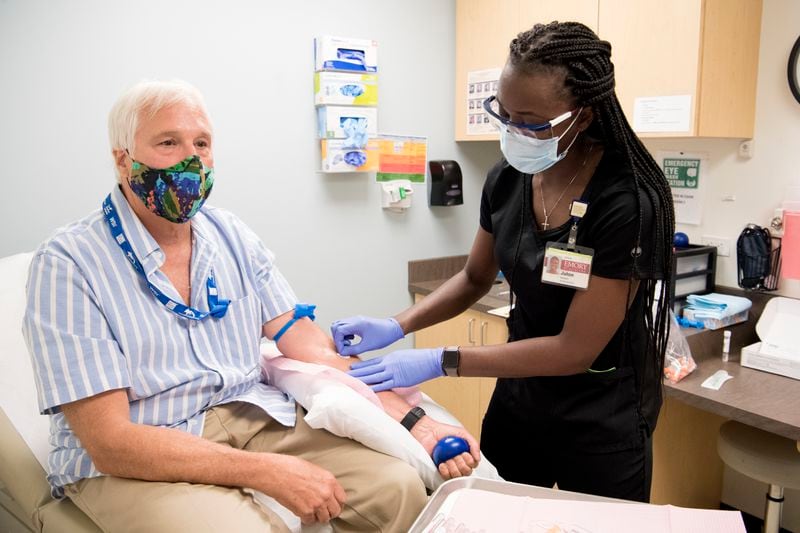While the fast-track development of a COVID-19 vaccine may seem like an enormous task, an even more daunting challenge may be getting approved vaccines into the arms of millions of people in Georgia and around the globe.
States have had to race to create their distribution plans by today, the deadline set by the federal government. Georgia will meet the deadline, according to a spokesperson for state Insurance Commissioner John King, who is also leading the state’s COVID-19 vaccine distribution task force.
But even after the state plan is submitted, Georgia will grapple with multiple logistical hurdles and questions, not to mention that officials don’t know which vaccine they will be distributing or even when — or if — one will be available.
“The reality is that a mass vaccination program at this scale is going to be a monumental task,” said Soumi Saha, a pharmacist, and director of advocacy at Premier, which arranges healthcare purchases for hospitals, nursing homes, and other providers. “And at this juncture, there are more questions than answers.”
The challenge ahead is unlike any other — the country has never had a vaccine for any coronavirus that has threatened in the past, such as SARS and MERS, and has never had such an urgent demand to produce so many doses so quickly.
Credit: Jack Kearse
Credit: Jack Kearse
It’s not the scale of mass vaccination in and of itself that is so challenging, said Julie Swann, a professor at North Carolina State University who in 2009 served as a senior adviser to the CDC on the national distribution for the H1N1 flu vaccine. She points to huge vaccination efforts in the past — close to 100 million doses of the H1N1 vaccine were administered in the U.S., and the flu vaccine is given each year to well over 100 million Americans.
Instead, it’s the complexity of storage, delivery, and tracking multiple vaccines with different requirements which makes this task so extraordinary, she said.
Sandy Springs-based UPS and Atlanta-based Delta Air Lines are already gearing up to play a part in distributing vaccines around the country.
One significant distribution challenge is that the two leading vaccine candidates, by Moderna and Pfizer, use a new RNA technology and require ultra-low temperature storage. This will require a supply chain that can keep vaccines in tightly controlled temperatures from the moment they are made, to the moment that they are administered. Pfizer has devised “thermal boxes” that, unopened, can keep a batch of vaccines frozen for up to 10 days; once opened, though, they have to be replenished with dry ice within 24 hours.
Along with temperature-controlled facilities, there will also be a need for monitoring capabilities and trained staff. Because vaccines will be very valuable, they also will need security to prevent tampering and theft.
Another challenge: A vaccine will likely require two doses. That means doubling production and persuading people to return for the second shot. If multiple vaccines are available at the same time, health-care providers will need to make sure that someone getting the first dose gets the appropriate second dose of the same vaccine.
Preparing to transport the vaccine
The Centers for Disease Control will play a central role in overseeing COVID-19 vaccinations, working with state and local health departments as it has in past epidemics.
The agency in August named McKesson Corp. a central distributor for the COVID-19 vaccines and related supplies. The company had an existing contract with CDC to distribute vaccines, and in 2009 and 2010 distributed more than 126 million doses of the H1N1 vaccine. The company will be reimbursed $178 million from the government to build new distribution centers and beef up existing distribution systems.
CDC said vaccines should be shipped directly to where they are administered whenever possible to prevent a break in the cold chain that likely will be essential. Otherwise, vaccination providers will need to follow manufacturers' cold-chain procedures, and will need to sign an agreement with CDC on conditions.
There is a lot of cold-chain pharmaceutical storage space in Georgia, said John Haber, CEO of Spend Management Experts, an Atlanta-based supply chain consulting firm.
“I think that Georgia is going to be well-positioned,” Haber said. “It’s very important for the state of Georgia to do a better job of distribution of vaccines than on the testing kits.”
In addition, UPS has been adding freezer farms in the United States and the Netherlands to prepare to store and ship COVID-19 vaccines. Near its Worldport air hub in Louisville, Ky., it is installing new freezers capable of storing vaccines at minus-20 to minus-80 degree temperatures.
However, the uncertainty of vaccine development and approvals means that “detailed supply chain protocols for storage and distribution are simply ‘what if’ scenarios at this point,” said UPS Healthcare president Wes Wheeler in a Q&A with trade publication Contract Pharma. “Essentially, supply chains must plan for any and every scenario, and build in contingency plans to avoid supply chain failures.”
UPS competitor FedEx is also preparing to transport vaccines. It has more than 90 cold chain facilities around the world and plans to open more in coming years.
FedEx Express CEO Donald Colleran noted another complicating factor for distribution during the company’s earnings call last month: It’s likely that the raw ingredients for any vaccine are going to come from one country and the manufacturing from another, while the need for the vaccine will be global.
Delta, which is certified by the International Air Transport Association to transport temperature- and time-sensitive pharmaceuticals, is also preparing to transport vaccines when they become available.
Many questions remain
With vaccine supplies extremely limited in the initial months, many other thorny questions about distribution remain: How many doses will each state get? And how do you make sure the vaccine is distributed fairly?
Experts say it’s not a simple population calculation, and a vaccine won’t be done on a first-come, first-served basis as vaccines traditionally have been given.
Instead, guidelines being drafted have health care workers and others whose jobs are considered essential in the pandemic on the top tier.
Georgia State University School of Public Health professor Dr. Harry Heiman said his primary concern is that vaccines are available to groups who have been disproportionately impacted by the disease, such as African Americans and Hispanics as well as high-risk populations, like prison workers and inmates.
“For me, that’s the more interesting and important challenge for us to address,” said Heiman, also a primary care physician.
Heiman suggested the state work with community health centers and faith-based organizations to create a pipeline for vaccine distribution and hold immunization events because those are trusted places in lower-income and rural communities. Polls show hesitancy to get a COVID-19 vaccine among in those communities due to a distrust of government.
Experts also say it is critical states track the vaccines, where they are, how being used and much vaccine is left. This is especially true for a new vaccine, where it will be critical to track safety carefully. Swann said Georgia and other states may need to invest in new information systems.
Georgia Tech professor Pinar Keskinocak, who is director of the university’s Center for Health and Humanitarian Systems, said another factor is whether vaccinations will be paired with antibody testing to “really target people who do not have any immunity.”
President Donald Trump said that once a vaccine has been approved, the U.S will be ready to begin distribution within one day. But Saha, with Premier, urged against rushing.
“You can’t go from approval to accessibility overnight,” he said. “Well, you could but you are likely to have too many holes to be successful. We want to see the country take a pause after FDA approval, and we want to see the collaboration of all of the states, and representatives from nursing homes and others to all come together and have a seat at the table and to coordinate. . .We want to see a holistic and cohesive plan to launch instead of a rushed and fragmented approach.”
Staff writer Eric Stirgus contributed to this article.








